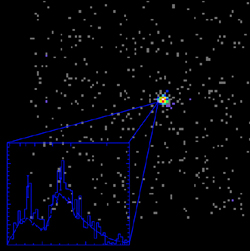November 3, 2000
CXC PR: 00-24
NASA’s Chandra X-ray Observatory has detected never-before-seen properties in the X-ray afterglow of a gamma-ray burst. This discovery strengthens the case for a “hypernova” model, where massive collapsed stars generate these mysterious blasts of high-energy radiation believed to be the most powerful explosions in the universe.
An international team of scientists used Chandra to observe iron emission lines from ejected material surrounding the gamma-ray burst (GRB) known as GRB991216. This is the first time emission lines associated with GRBs have been unambiguously detected and their properties precisely measured at X-ray wavelengths.
Astronomers have long debated how GRBs originate. One theory contends that GRBs result when two “compact objects,” that is, neutron stars or black holes, collide and coalesce. Another theory speculates that a “hypernova,” a gigantic star collapsing on itself under its own weight, could cause these extremely energetic outbursts.
“The discovery of iron lines in the X-ray spectrum is an important clue to our understanding of GRBs,” said Luigi Piro, lead author of the paper that appeared in the November 3 issue of the journal Science. “Studying the immediate area around the GRB tells us a great deal about the origin of the GRB itself.”
A shift in the wavelength, or energy, of the detected iron line emission (relative to what would be seen in a laboratory) tells the researchers the distance to the GRB. The Chandra team determined that it has taken roughly 8 billion years for the X rays from GRB991216 to reach the Earth, in agreement with an independent estimate from an absorption feature in the optical light from the host galaxy.
From the distance and the intensities of the detected X-ray emission lines, the investigators deduced the properties of the ejected material and its relationship to the GRB. The team was able to determine the mass of the medium within a light day or two of the GRB as approximately equivalent to at least one-tenth that of the Sun. By analyzing the widths of the detected spectral lines, the researchers found that the material surrounding GRB991216 is moving away very quickly (approximately 10 percent the speed of light).
“The most straightforward scenario that emerges from all of the evidence we have gathered is that a massive progenitor – like a hypernova – ejects matter, shortly before the GRB,” said Piro. “In other words, our data helps rule out the scenario where two neutron stars or black holes collide. We think GRBs result from something similar to a supernova explosion, but much more powerful.”
Although still unclear, scientists speculate that the initial shedding of material (perhaps the outer envelope of the hypernova) is followed by an event (the GRB) at the core of the hypernova – most likely a collapse to a black hole. Energy released by the fireball of the GRB would then heat up the previously ejected material, producing the optical and X-ray afterglows lasting days or weeks after the GRB.
While GRB afterglows have been studied in the optical, radio, and X-ray regimes for some time, high precision X-ray observations were needed to measure the properties of dense, massive medium that would exist if the scenario of a massive progenitor were true. With Chandra, the scientists believe they are seeing the iron emission that is predicted if the surrounding medium becomes heavily ionized and recombination takes place after being hit with the radiation produced by the GRB and its afterglow.
GRB991216, first detected by the Burst and Transient Source Experiment (BATSE) aboard the Compton Gamma-ray Observatory on December 16, 1999, was one of the brightest GRBs ever found by that instrument. A more accurate GRB position was obtained by the Rossi X-ray Transient Explorer. Chandra was able to reorient quickly in order to observe the event on December 18, while the flux level was still high. This allowed Piro and his team to observe GRB991216, using Chandra’s High Energy Grating Spectrometer (HETG) in conjunction with the Advanced CCD Imaging Spectrometer (ACIS) on December 18, 1999, for 3.4 hours.
The research team included Penn State’s Gordon Garmire, principal investigator for the ACIS instrument, Michael Garcia of the Harvard-Smithsonian Center for Astrophysics, and other colleagues from the United States, Italy, Japan, and the Netherlands.
The ACIS X-ray camera was developed for NASA by Penn State and MIT. The High Energy Transmission Grating Spectrometer was built by MIT. NASA's Marshall Space Flight Center in Huntsville, AL, manages the Chandra program. TRW, Inc., Redondo Beach, California, is the prime contractor for the spacecraft. The Smithsonian's Chandra X-ray Center controls science and flight operations from Cambridge, MA.
Images associated with this release are available on the World Wide Web at:
MEDIA CONTACTS
Dolores Beasley
Headquarters, Washington, DC
Phone: 202-358-1753
Steve Roy
Marshall Space Flight Center, Huntsville, AL
Phone: 256-544-6535
Megan Watzke
Chandra X-ray Observatory Center, CfA, Cambridge, MA
Phone: 617-496-7998



